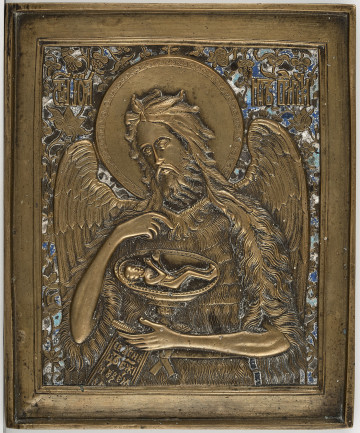
St. John the Baptist
20th century
Castle Museum in Łańcut
Part of the collection: Icons
Revered in both Eastern and Western Christianity, Nicholas the Wonderworker was the archbishop of Myra in Asia Minor. He lived in the 3rd/4th c., during the reign of emperors Diocletian and Constantine the Great; he was known for numerous miracles. In the Christian East, his cult had been developing already since the 5th c. and came to Rus from Byzantium. Along with the cult, the earliest depictions of the saint appeared in Rus and over the centuries, many variants of his portrayals developed. On most icons of St. Nicholas, already since the 10th c., he is accompanied by the figures of Christ and His Mother, who marked him for episcopacy and hand him the insignia of the office - the Gospels and omophorion. Since the 14th c., depictions of Christ and His Mother on the icons of St. Nicholas have been associated with a legend. Nicholas the Wonderworker was supposed to attend the first general church council, the Council of Nicaea in 325. According to the story cited in his frequently replicated hagiographies, he supposedly struck the heretic Arius across the face. For this offence, St. Nicholas was removed from the episcopal office. Then, Christ and His Mother appeared, restoring the saint to the post that he lost as punishment. In Rus, this legendary narrative coexisted with other stories about St. Nicholas's miracles, where the saint was considered the first benefactor in every need, as evidenced by numerous paintings, see S.12683MŁ, S.12796MŁ, S.12806MŁ, S.12820MŁ, S.12836MŁ, S.12868MŁ, S.12950MŁ. Among those commonly used were small metal icons depicting St. Wonderworker of Myra in half-figure. On the presented icon, the saint holds the Gospel in his left hand and gives a blessing with his right. The outstretched index and middle fingers are arranged in the traditional old Rus 'dwupierstie'. The Old Believers remained faithful to this gesture - they did not accept the 17th-century liturgical reforms which introduced, among other changes, a new way of making a cross with three connected fingers. Teresa Bagińska-Żurawska https://orcid.org/0000-0002-9243-3967
Dimensions
height: 6.5 cm, width: 4.3 cm
Object type
Icons
Technique
cast
Material
bronze
Origin / acquisition method
decyzja administracyjna
Creation time / dating
Creation / finding place
Owner
Castle Museum in Łańcut
Identification number
Location / status

20th century
Castle Museum in Łańcut

19th (?) century
Castle Museum in Łańcut

1800 — 1850
Castle Museum in Łańcut
DISCOVER this TOPIC
National Museum in Lublin
DISCOVER this PATH
Educational path